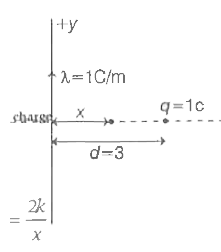An infinite line of charge with uniform line charge density of 1 C/m is palced along the y -axis. A charge of 1C is placed on the x-axis at a distance of d= 3m from the origin .
At what distance r from the origin on the x-axis , the total electric field is zero.
(Assume , 0<r<d ) Solution in Telugu
1 m
2 m
2.5 m
1.75 m
The correct Answer is:B
An infinite line of uniform charge density is placed along y- axis and a charge (+1C) is placed at x=+3 m as shown in the figure

For electric field be zero at x, there should be
Eline charge=Epoint charge ….. (i)
As we know, for line charge
Eline charge=2kλx=2kx ........(ii)
Similarly for point charge,
Epoint charge=kq(3−x)2=k(3−x)2......(iii)
From Eqs. (i) , (ii) and (iii) we get
2kx=k(3−x)2⇒2x=1(3−x)2
⇒2x2−13x+18=0
This is a quadratic equation, which have solution
x1,x2=13±√132−1444
So, x1=4.5m (not possible, as 0<x<3)
and x2=2m.
Topper's Solved these Questions
Similar Questions
Match the following fundamental forces of nature with their relative strength.
List-IList-II(A)Strong nuclear force(i)10−2(B)Weak nuclear force(ii)1(C)Elextromagnetic force(iii)10−39(D)Gravitational force(iv)10−13
The correct match is
View SolutionIdentify the correct option.
View SolutionAn infinite number of charges, each of charge 1μC are placed on the x-axis with co-ordinates x=1,2,4,8….∞ If a charge of 1C is kept at the origin, then what is the net force action on 1C charge
View SolutionA point charge q is placed at the origin . How does the electric field due to the charge very with distance r from the origin ?
View Solution(a) There is a long uniformly charged cylinder having a volume charge density of ρC/m3. Radius of the cylinder is R. Find the electric field at a point at a distance x from the axis of the cylinder for following cases (i) x lt R (ii) x gt R What is the maximum field produced by the charge distribution at any point? (b) The cylinder described in (a) has a long cylindrical cavity. The axis of cylindrical cavity is at a distance a from the axis of the charged cylinder (see figure). Find electric field inside the cavity.

View SolutionA solid non-conduction cylinder of radius R is charge such that volume charge density is proporation to r where r is distance from axis. The electric field E at a distance r(r lt R) well depend on r as.
View SolutionA charge of 2C is placed on the x -axis at 1m from the origin along - ve x-axis.Infinite number of charges each of magnitude 2C are placed on x-axis at 1m,2m,4m,...from origin along + ve x -axis.The first charge is positive and alternate charges are of opposite in nature.The electric field intensity at the origin?
View SolutionShow graphically the variation of electric field E (y-axis) due to a charged infinite plane sheet with distance r (x-axis) from the plate.

View SolutionShow graphically the variation of electric field E (y-axis) due to a charged infinite plane sheet with distance r (x-axis) from the plate.

View SolutionThere exists a uniform electric field E=4×105Vm−1 directed along negative x-axis such that electric potential at origin is zero. A charge of −200μC is palced at origin, and a charge of +200μC is placed at (3m,0). The electrostatic potential energy of the system is
View SolutionAn infinite number of charges each q are placed in the x-axis at distances of 1, 2, 4, 8, ………meter from the origin. If the charges are alternately positive and negative find the intensity of electric field at origin.
View SolutionAn infinite number of charges each of value Q are palced on the x-axis at distances of 1, 2, 4, 8, ….. meter from the origin. If the charges are alternately positive and negative find the electric field (Intensity of electric field) at origin.
View SolutionA charge of magnitude 1C is placed at origin. Infinite number of charges placed on y-axis at coordinates of 1m, 2m, 4m, 8m,...... of magnitude 1μC. Then find force exerted by these charge on the charge placed at origin
View SolutionAn infinite number of charges, each of charge 1 mu C are placed on the x -axis with co-ordinates x=1,2,4,8….oo If a charge of 1C is kept at the origin, then what is the net force action on 1C charge
View SolutionA point-charge q is placed at the origin. How does the electric field due to the charge vary with distance r from the origin?
View Solution
